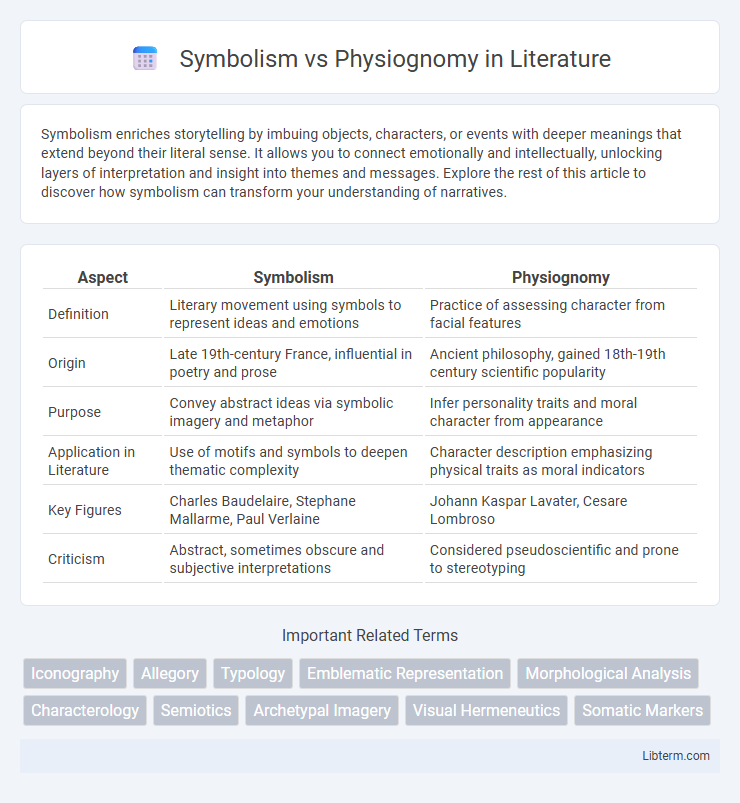Symbolism enriches storytelling by imbuing objects, characters, or events with deeper meanings that extend beyond their literal sense. It allows you to connect emotionally and intellectually, unlocking layers of interpretation and insight into themes and messages. Explore the rest of this article to discover how symbolism can transform your understanding of narratives.
Table of Comparison
| Aspect | Symbolism | Physiognomy |
|---|---|---|
| Definition | Literary movement using symbols to represent ideas and emotions | Practice of assessing character from facial features |
| Origin | Late 19th-century France, influential in poetry and prose | Ancient philosophy, gained 18th-19th century scientific popularity |
| Purpose | Convey abstract ideas via symbolic imagery and metaphor | Infer personality traits and moral character from appearance |
| Application in Literature | Use of motifs and symbols to deepen thematic complexity | Character description emphasizing physical traits as moral indicators |
| Key Figures | Charles Baudelaire, Stephane Mallarme, Paul Verlaine | Johann Kaspar Lavater, Cesare Lombroso |
| Criticism | Abstract, sometimes obscure and subjective interpretations | Considered pseudoscientific and prone to stereotyping |
Introduction to Symbolism and Physiognomy
Symbolism explores the use of images and signs to represent abstract ideas and emotions, emphasizing deeper meaning beyond the literal appearance. Physiognomy involves interpreting character or personality traits from physical features, particularly facial expressions, to infer inner qualities. Both approaches analyze human attributes but differ in focusing on symbolic representation versus physical characteristics.
Historical Origins of Symbolism
Symbolism originated in the late 19th century as a literary and artistic movement emphasizing the representation of ideas and emotions through symbolic imagery rather than direct description. Emerging from French poets like Charles Baudelaire and Stephane Mallarme, Symbolism rejected naturalism and sought to express the ineffable through metaphors and allegories. This movement influenced various art forms, including painting and literature, shaping modernist thought by prioritizing subjective experience over external reality.
Ancient Roots of Physiognomy
Physiognomy, rooted in ancient Greek and Egyptian traditions, interprets facial features to reveal character traits, contrasting with symbolism which uses abstract signs to represent ideas. Ancient thinkers like Aristotle codified physiognomy as a science, linking physical appearance to psychological disposition. This historic foundation laid the groundwork for physiognomy's influence on art, medicine, and psychology throughout classical antiquity.
Core Principles of Symbolism
Symbolism centers on the use of symbols to represent ideas, emotions, or concepts beyond their literal meaning, emphasizing the subjective and allegorical interpretation of imagery. Core principles include the belief that objects or figures carry deeper, often mystical significance, encouraging viewers to uncover hidden meanings through metaphor and suggestion. Unlike physiognomy, which analyzes physical appearance to infer character traits, symbolism prioritizes abstract representation to evoke universal truths and internal states.
Foundational Concepts of Physiognomy
Physiognomy centers on interpreting character traits through facial features, linking physical appearance with psychological attributes based on empirical observation. Foundational concepts of physiognomy emphasize anatomical structures, such as the shape of the eyes, nose, and mouth, to predict personality tendencies and emotional states. This approach contrasts with symbolism, which relies on abstract representations and metaphorical meanings rather than direct physical analysis.
Symbolism in Art and Literature
Symbolism in art and literature emphasizes the use of symbols to represent ideas, emotions, and states of mind beyond literal meanings, creating layers of interpretive depth. Symbolist artists and writers employ motifs, colors, and metaphorical imagery to evoke spirituality, dreams, and the subconscious, challenging realist conventions. This movement flourished in the late 19th century, influencing figures like Gustave Moreau, Stephane Mallarme, and Odilon Redon, who sought to transcend physical reality through evocative symbolism.
Physiognomy in Culture and Society
Physiognomy, the practice of assessing a person's character or personality from their outer appearance, particularly the face, has influenced cultural and societal beliefs for centuries, shaping social judgments and stereotypes. It permeates various cultural narratives, art, and literature, often reinforcing biases about identity, morality, and status based on physical traits. Despite scientific criticism, physiognomy's impact persists in social profiling, media representations, and popular psychology, reflecting enduring intersections between appearance and perceived character within human societies.
Scientific Critiques and Ethical Concerns
Scientific critiques of symbolism highlight its subjective interpretations, challenging empirical validation and reproducibility in psychological research. Physiognomy faces ethical concerns due to its historical misuse in justifying racial and social discrimination, undermining personal dignity and equality. Both approaches demand rigorous ethical scrutiny to prevent biases and promote scientific integrity in behavioral and personality studies.
Comparative Analysis: Symbolism vs Physiognomy
Symbolism and physiognomy represent distinct approaches to interpreting human traits: symbolism emphasizes abstract representation and cultural meanings behind symbols, while physiognomy focuses on reading facial features to infer character or personality. Symbolism relies on metaphorical and subjective associations, often varying across cultures and historical contexts, whereas physiognomy attempts to establish a direct correlation between physical appearance and inner qualities, though it lacks scientific validation. The comparative analysis highlights symbolism's flexibility and cultural depth versus physiognomy's controversial claims and deterministic perspective on human nature.
Modern Relevance and Future Perspectives
Symbolism in literature and art continues to shape contemporary narratives by imbuing works with layered meanings that resonate across cultures, while physiognomy's scientific credibility has significantly declined due to its association with pseudoscience and ethical concerns. Modern relevance of symbolism is evident in digital media, where symbolic imagery enhances user experience and cultural identity, whereas physiognomy faces critical scrutiny in AI ethics and facial recognition technology due to potential biases. Future perspectives suggest symbolism will evolve with advancements in virtual and augmented reality, deepening immersive storytelling, while physiognomy's principles may be reinterpreted cautiously within psychology and behavioral studies, emphasizing empirical validation and ethical standards.
Symbolism Infographic

 libterm.com
libterm.com